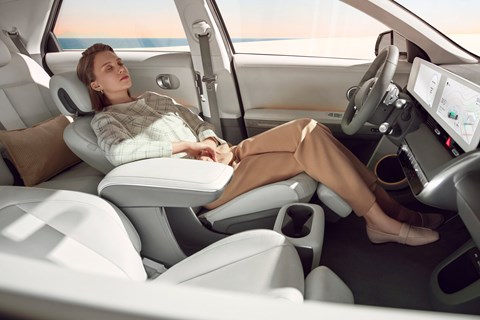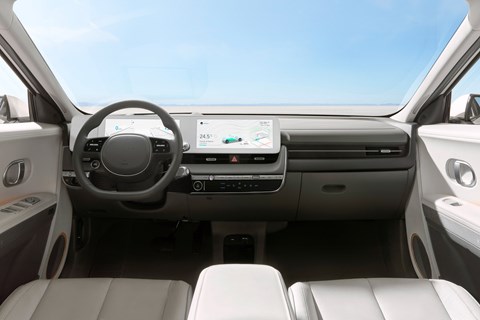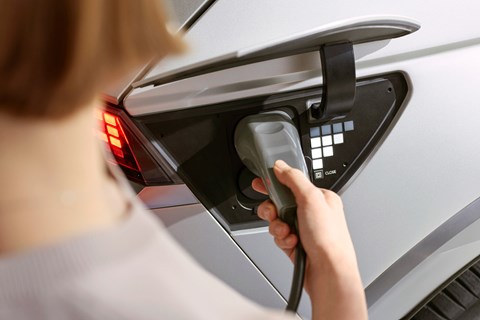► Hyundai Ioniq sub-brand’s first car
► All-electric hatchback with retro looks
► New battery and mirror tech for 2023 MY
Hyundai is adding technology to the Ioniq 5 EV for the 2023 model year. A range-boosting 77.4kWh battery replaces the 72.6kWh option and the South Korean manufacturer has also added some additional technology into the mix.
Standard-fit battery conditioning tech helps optimise performance before and after charging by pre-heating or cooling the pack. So if you’re travelling to a high-voltage charging point, the Ioniq 5 will now get its battery into the optimum condition for topping-up the moment you arrive. All you need to do is have a charging point selected in the car’s navigation system.
Standard on the new Namsan Edition Ioniq 5, Digital Side Mirrors (DSMs) arrive in Europe for the first time on a Hyundai. Delivering reduced wind noise and efficiency, they are claimed to provide a better view for drivers, and are joined by the Digital Centre Mirror. Reshuffled specifications also mean vehicle to load (V2L) is now standard on all but the most basic Ioniq 5, while Premium models can be equipped with a heat pump to precondition the cabin without using the battery.
The Digital Centre Mirror provides adaptable rear views using a camera in the spoiler, and can auto-dim and provide an unobstructed view even with rear passengers obstructing the view over the driver’s shoulder. The Ioniq 5’s lack of a rear wiper means you’ll appreciate the extra visibility, too…
Check out the 5’s saloon sibling: the new Hyundai Ioniq 6
Hyundai Ioniq 5: everything you need to know
The Ioniq 5 is a VW ID.4 rival that started life as the 45 Concept car – one of the Hyundai’s best recent concepts in our book, and one that comes with a whole host of technology inside and out.
Along with the super-clean surfaces and crisp lines, pixellated ‘parametric’ LEDs front and back and active aero dynamics outside, with an airy, spacious and not overly touch-panelled interior to look forward to. In fact, Hyundai says it’s also roomy enough inside that you can live in it.

I’m sorry, what?
Yes, Hyundai is promoting a ‘living space’ with the new 5, pointing out that – given it’s an EV – you’re likely to spend more time than usual in your car, particularly while it charges on long journeys.
The E-GMP flat-floor platform provides the Ioniq 5 with a long wheelbase – 3000mm, longer than that of Hyundai’s massive Stateside Palisade – and the ability to have a sliding centre console. The seats recline (like in pretty much every car) but also have dinky footrests that pop out if you really recline them, allowing you to snooze while your car charges. While the front seats are full on La-Z-Boys, the rear bench can slide fore or aft, and boot space is a respectable 531 litres.

The interior itself is a clean environment, and Hyundai has balanced the large twin screens with a neat central dashboard area with physical switchgear, much like the Honda e. Hyundai says details like an augmented-reality head-up display (like that on VW’s ID.3 and ID.4, and the latest Mercedes S-Class) is available, as is the brand’s Blind Spot View Monitor first seen on the Nexo fuel cell car and, more recently, the latest Tucson.
There are plenty of environmentally friendly details inside and out, too. The paint uses plant waste, and the cockpit utilises recycled PET bottles in panels, eco treated leather and a paper-like material used on the door handles. More pertinently, you can spec a solar panel on the roof. While that’s not a novel idea (the Mk1 Nissan Leaf had that to power ancillaries like the air con), Hyundai’s engineers claim it can add two to three miles of range a day.

Hyundai is giving you the power of choice with two power outputs that are linked to two different battery sizes (58kWh and 72.6kWh), and two drive options (rear- or all-wheel drive). The one with the most range – the 72.6kWh rear-driven option claims up to around 300 miles on a charge, while the fastest one can sprint to 62mph in 5.2 seconds. All power variants are capable of a 115mph top speed.
Replacing the 72.6kWh option, the 77.4kWh battery from mid-2022 onwards increases range to 315 miles and adds 10bhp to the power on off.

The E-GMP platform allows both 400-volt and 800-volt charging capabilities, with Hyundai claiming the Ioniq 5 can be charged from 10 to 80 per cent in around 18 minutes on the fastest (and rarest) 350kW chargers.
More interestingly, though, is the Ioniq 5’s ‘vehicle to load’ function. Hyundai can supply you with an adapter for the car’s charging port, allowing you to actually use the Ioniq to charge other things. Yes, there is a power outlet inside the car, but this adaptor allows you to charge things like e-bikes and e-scooters, along with power tools and even another EV in desperate need of juice.

When and how much?
The first versions of Hyundai’s new Ioniq 5 arrived in the summer of 2021. The latest revision, referred to as MY2023, starts at £39,400 for the 58kWh, RWD SE Connect, and goes all the way to £56,400 for the Namsan Edition with 77.4kWh battery and AWD.
Read our Hyundai reviews